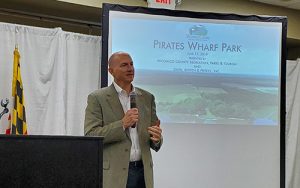
SALISBURY – Plans for the development of a public park were presented to citizens in Wicomico County this week.
On Monday, officials with Davis, Bowen & Friedel presented the public with a draft master plan of a county-owned property known as Pirate’s Wharf.
“We were able to start a planning effort, which you will see tonight, and hopefully we will end with a regional park that both our citizens and our visitors will be able to enjoy,” said Steve Miller, the county’s director of recreation, parks and tourism.
Last October, County Executive Bob Culver announced the county had received an $820,000 grant from the National Parks Service through the Land and Water Conservation Fund to create a public park on the 340-acre property. And with the help of matching grants and a financial commitment from the Wicomico County Council, the county was able to leverage the federal funding to generate $1.8 million for the first phase of the project.
“More than the funding, what we are very pleased about is providing access to one of the most beautiful spots in Wicomico County,” Miller said. “That’s really been the goal of this project from the very beginning, to increase public access and increase our quality of life as citizens of the county.”
An event area, a boat ramp and an extensive trail system were just a few of the park elements featured in the proposed master plan presented this week. Michael Wigley, principal at Davis, Bowen & Freidel, said the comprehensive document featured low-impact recreational activities that enhanced the natural surroundings at Pirate’s Wharf, which is located along the Wicomico River.
“I think we settled on what we would call a low-impact park,” he said, “which is one that is not particularly active in the offerings it has, but one that does allow for enjoyment of the natural setting.”
In the first phase of the park’s development, the master plan proposes a 1,500-square-foot pavilion with an adjacent comfort station and playground, a boat ramp and soft launch area, a fishing pier and observation deck overlooking the river, and three parking sites. The plan also features wildlife corridors and historical markings along an extensive trail system.
“We wanted to create a sense of wonder and exploration with the location of these trails,” Wigley said.
Wigley also provided the public with an overview of the second phase of the park’s development, which features additional trails, parking and event space.
“It’s still to be determined and we will be looking for public input for future phases,” he said. “But we wanted to give you a glimpse of how the whole master plan comes together at some point.”
Joan Maloof, an ecologist who lived on the Pirate’s Wharf property for 30 years, questioned how the county would improve and protect the 225 acres of forested land not included in the master plan.
“Two-thirds of Pirate’s Wharf park is not shown here, and that’s the forest across the road,” she said. “And although you don’t have any plans for it in this phase, that could be a mistake because the trails that are there could use a little improvement.”
Maloof added that she would also like to see restrictions placed on the forested area.
“I think it’s very important at this initial phase that we put a conservation easement on that forest,” she said. “What that will do is ensure that forest will never be opened to logging … We should build that into the budget now.”
Senior Project Manager Ken Eaton told Maloof the firm had explored the possibility of improving the trail system within the forest, but ultimately decided to direct the budget to projects that would improve public access near the water.
“We thought the funds would be better spent getting the core part of the park done in Phase I,” he said.
Miller added that the county would also continue to explore easement options in the future.
“Certainly $1.8 million is a lot of money, but when you go into this adding infrastructure and parking none of this is inexpensive,” he said. “There are protections to keep this a recreational space, but to go beyond that is something the county would need to weigh the pros and cons of.”
Attendee Don Ross questioned if the county would be required to do additional archeological studies of the property.
“I hear talk of the historical importance of these areas, but nothing about the prehistoric significance of this area,” he said.
Miller said an environmental assessment of the property – which will be completed this summer – would indicate the need for additional studies.
“As part of accepting these federal monies, we are required to do an environmental assessment …,” he said. “It will include recommendations and requirements for the level of archeological services.”
Attendee Niamh Shortt asked if the county would limit the size of recreational boats using the boat ramp.
“With the small area we have to turn around at the boat ramp, if a guy with a large boat comes in here once he’s probably not coming back twice,” Eaton replied.
Miller said the next step in implementing the first phase of the Pirate’s Wharf project would include additional engineering and permitting. The federal grant stipulates the project must be completed by 2022.

